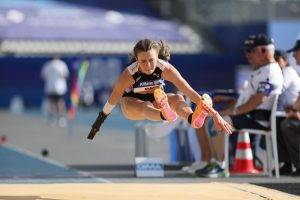The world of athletics, a realm where speed, strength, and skill converge, showcases the pinnacle of human achievement. Among the myriad disciplines, the women’s long jump stands as a testament to prowess, precision, and the pursuit of pushing physical boundaries. In this extensive exploration, we embark on a journey through the history, nuances, and remarkable feats that define the Women’s Long Jump World Record, unraveling the stories of those who soared to unprecedented heights.
Understanding the Women’s Long Jump
Foundations of the Event: Leaping into History
Long Jump Basics:
The women’s long jump is a track and field event that involves athletes sprinting down a runway and leaping as far as possible into a sandpit. The length of the jump is measured from the takeoff point to the closest landing point in the sand. This dynamic display of athleticism combines speed, technique, and explosive power.
Historical Evolution:
- The women’s long jump has evolved significantly over the years, with advancements in training methodologies, equipment, and understanding of biomechanics contributing to the continual rewriting of records. From the early days of athletic competition to the modern era, the long jump has remained a captivating spectacle for fans worldwide.
Key Components: Technique and Approach
Runway Approach:
Athletes typically have a runway of fixed length to generate the necessary speed for a powerful takeoff. The approach involves a delicate balance between acceleration and maintaining optimal control, setting the stage for the jump.
Takeoff Technique:
The takeoff, executed from a wooden board at the end of the runway, demands precise timing and coordination. Athletes leverage a combination of speed, strength, and proper technique to achieve an optimal takeoff angle, maximizing their horizontal distance.
Flight Phase:
In mid-air, athletes transition into the flight phase, where body position, posture, and aerodynamics play critical roles. A well-executed jump requires mastering techniques such as the hitch kick or the hang technique, allowing athletes to extend their bodies for maximum distance.
Landing in the Sandpit:
- The landing phase, concluding with a graceful landing in the sandpit, completes the long jump sequence. Athletes strive to achieve the greatest distance while ensuring a safe and legal landing, avoiding fouls that could nullify their efforts.
The Pursuit of the World Record
The Current Record: An Overview
Standing Tall:
The current Women’s Long Jump World Record holder stands as a symbol of excellence, having achieved a jump that surpassed all previous marks. The record-setting performance is a culmination of talent, training, and a moment of peak athletic prowess.
Historical Context:
- Understanding the current record necessitates delving into its historical context. How does it compare to past records, and what distinguishes the current record-holder from those who came before? Exploring the lineage of records provides insights into the evolving standards of elite long jumping.
Era-Defining Performances: Breaking Down Barriers
Game-Changing Moments:
The Women’s Long Jump World Record has witnessed transformative moments that redefined what was deemed physically possible. Each era introduces athletes who, through a combination of talent and determination, push the boundaries of human performance.
Pioneering Athletes:
Pioneering athletes in the women’s long jump have paved the way for subsequent generations. Their record-setting performances not only mark personal triumphs but also contribute to the broader narrative of women’s participation and success in sports.
Technological Advancements:
- Advancements in sports science, equipment, and training methodologies have played a role in record-setting performances. From improved footwear to state-of-the-art training facilities, athletes benefit from an evolving landscape that enhances their ability to reach new heights.
Breaking Down the Numbers
The Measurement Standard: How Records Are Validated
Metric Measurement:
Long jump records are measured in meters, aligning with the metric system used in international athletics. The precision of measurements, often extending to centimeters, underscores the meticulous nature of record-keeping in the sport.
Wind Readings:
- External factors, particularly wind conditions, can significantly impact long jump performances. Official records are contingent on meeting specific wind-reading criteria to ensure fairness and eliminate undue advantages or disadvantages for athletes.
Notable Records: Charting the Progression
Record Progression:
Examining the progression of the Women’s Long Jump World Record unveils a timeline of remarkable achievements. From modest beginnings to the current pinnacle, each record-holder has left an indelible mark on the sport, contributing to the ongoing legacy of the event.
Landmarks in History:
Certain record-setting performances stand out as landmarks in the history of the Women’s Long Jump. Whether it’s breaking through a distance threshold or achieving consecutive record improvements, these moments shape the collective memory of the sport.
Global Representation:
- The Women’s Long Jump World Record has transcended borders, with athletes from diverse nations etching their names in the record books. The global representation underscores the universality of athletic achievement and the shared pursuit of excellence.
Influential Factors in Long Jump Performance
Biomechanics: The Science of Optimal Movement
Biomechanical Efficiency:
Long jump performance is intricately linked to biomechanics, the study of movement in living organisms. Athletes aim to optimize their biomechanics to achieve maximum efficiency in each phase of the jump, from takeoff to landing.
Strategic Training:
Coaches and athletes collaborate to design training regimens that enhance specific aspects of biomechanics. Plyometrics, strength training, and technical drills contribute to the development of explosive power, coordination, and the nuanced movements critical for long jump success.
Individual Variances:
- Recognizing the individual variances in athletes’ biomechanics underscores the personalized nature of training. Tailoring approaches based on athletes’ strengths, weaknesses, and physiological characteristics is essential for unlocking their full potential.
Nutrition and Fitness: Fueling Performance
Energy Demands:
Long jump athletes face significant energy demands during training and competition. Proper nutrition, including a balance of macronutrients and micronutrients, is crucial for sustaining performance, promoting recovery, and minimizing the risk of injuries.
Strength and Conditioning:
Long jumpers engage in targeted strength and conditioning programs to enhance their physical attributes. A combination of explosive strength, speed, and flexibility contributes to the overall fitness required for optimal long jump performance.
Recovery Protocols:
- The rigors of training and competition necessitate effective recovery protocols. Adequate rest, hydration, and recovery strategies, including massage and physiotherapy, play pivotal roles in sustaining peak physical condition.
Influential Performances and Athletes
Legendary Figures: Icons of Long Jump Excellence
Jackie Joyner-Kersee:
A trailblazer in the women’s long jump, Jackie Joyner-Kersee’s performances remain iconic. Her multi-event prowess, highlighted by long jump success, set the standard for versatility and excellence in track and field.
Heike Drechsler:
Heike Drechsler’s dominance in the long jump during the 1980s and 1990s left an indelible mark. The German athlete’s technical proficiency and consistent success solidified her status as one of the all-time greats in the event.
Florence Griffith-Joyner:
- Known for her unparalleled speed, Florence Griffith-Joyner’s contributions to the long jump elevated the event’s profile. Her combination of sprinting prowess and long jump excellence showcased the interconnectedness of various track and field disciplines.
Strategies for Long Jump Success
Technical Mastery: Perfecting the Jumping Form
Runway Approach Techniques:
Athletes refine their runway approaches to achieve optimal takeoff angles and launch positions. The nuances of the approach, including stride patterns and acceleration strategies, contribute to a successful takeoff.
In-Air Techniques:
The flight phase demands precise body control and posture adjustments. Athletes work on techniques such as leg cycling, arm movements, and mid-air adjustments to optimize their trajectory and maximize distance.
Landing Proficiency:
- Training encompasses landing techniques that prioritize both distance and safety. Athletes practice landing drills to develop muscle memory and ensure a seamless transition from flight to sandpit.
Mental Preparedness: Conquering the Psychological Aspect
Visualization Techniques:
Long jumpers employ visualization techniques to mentally rehearse successful jumps. Visualizing the approach, takeoff, flight, and landing sequences enhances focus, confidence, and preparedness for competition.
Pressure Management:
Thriving in competitive environments requires effective pressure management. Athletes and coaches collaborate on mental resilience strategies to navigate the psychological challenges inherent in high-stakes competitions.
Goal Setting:
- Establishing clear, achievable goals serves as a motivational framework for long jumpers. Whether aiming for personal records, championships, or international acclaim, goal-setting fosters a sense of purpose and direction in training and competition.
Notable Achievements and Records
Breaking Barriers: Setting New Standards
World Record Moments:
World record moments in the Women’s Long Jump encapsulate the intersection of talent, training, and the pursuit of greatness. Each record-setting performance redefines what is deemed physically possible, leaving an indelible mark on the history of the event.
Olympic Triumphs:
Long jump achievements at the Olympic Games stand as crowning moments in athletes’ careers. The intensity of global competition and the historical significance of Olympic success add layers of prestige to medal-winning performances.
Continental and National Records:
- Beyond global competitions, continental and national records showcase the depth and diversity of long jump talent worldwide. Athletes representing their countries or regions contribute to a rich tapestry of achievements that collectively shape the global narrative of the event.
The Future of Women’s Long Jump
Advancements in Training Methodologies: A Glimpse Ahead
Technology Integration:
The integration of technology in training methodologies is poised to revolutionize long jump preparation. From biomechanical analysis using motion capture to virtual reality simulations, athletes can leverage cutting-edge tools for enhanced skill development.
Data-Driven Coaching:
Coaches increasingly rely on data-driven insights to tailor training programs. Athlete performance metrics, injury prevention analytics, and real-time feedback contribute to more personalized and effective coaching strategies.
Cross-Disciplinary Training:
- Long jumpers of the future may engage in cross-disciplinary training, incorporating elements from other sports or specialized fields. The holistic approach aims to enhance overall athletic abilities, promoting versatility and adaptability in competition.
Related Post:
Unveiling the Dynamics: The Essence of Sports with Goalposts
Unveiling the Strategic Dimensions of the PGA Cut Line: An In-Depth Exploration
Exploring the Crucial Role of Tight Ends in Football: What Does a Tight End Do on the Field
In the realm of women’s long jump, each leap represents more than a physical feat—it is a testament to human potential, perseverance, and the pursuit of excellence. From the historic achievements of trailblazing athletes to the meticulous training regimens that push boundaries, the Women’s Long Jump World Record stands as a beacon of inspiration.
As the sport evolves, so too will the narratives etched in the sandpits of global competitions. The future of women’s long jump promises technological advancements, data-driven insights, and an ongoing quest to surpass the benchmarks of today. Whether in the pursuit of world records, Olympic glory, or personal triumphs, long jumpers will continue to embody the spirit of soaring beyond limits, leaving an enduring legacy in the annals of athletics. As the sand settles and measurements are recorded, the essence of the women’s long jump prevails—an ever-ascending journey of human potential reaching new heights on the wings of determination and skill.



